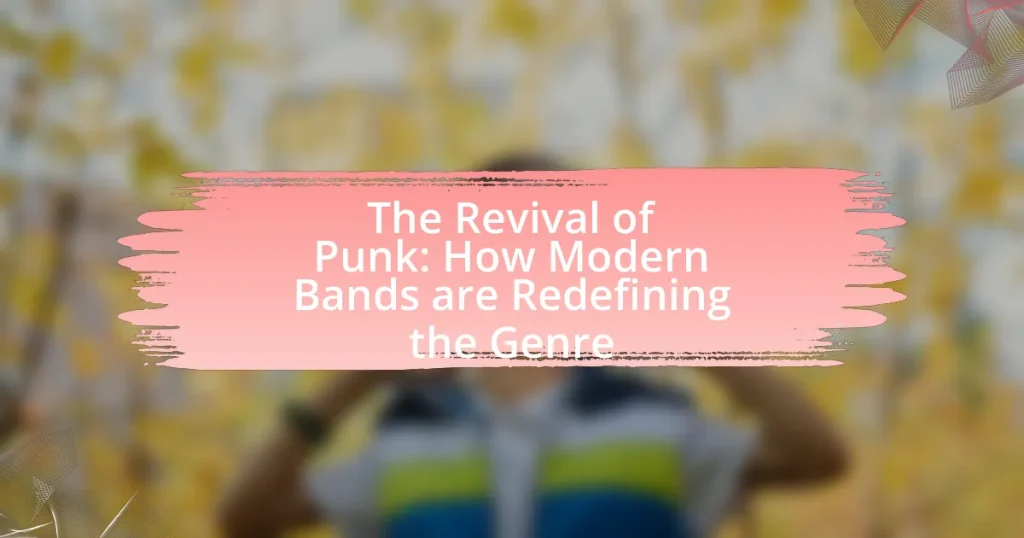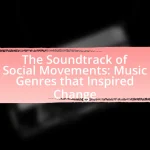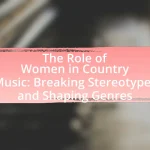The Revival of Punk refers to the resurgence of punk music and culture that began in the late 2000s, characterized by a return to the genre’s roots, emphasizing raw sound, DIY ethics, and social and political commentary. This article explores the evolution of punk from its inception in the 1970s to its contemporary forms, highlighting key modern bands such as Idles, Fontaines D.C., and Amyl and the Sniffers that are redefining the genre. It examines the socio-political influences driving this revival, the incorporation of diverse musical styles, and the significance of DIY culture and technology in promoting punk music today. Additionally, the article discusses how modern punk bands engage with audiences and address contemporary themes, ensuring the genre’s relevance in today’s cultural landscape.
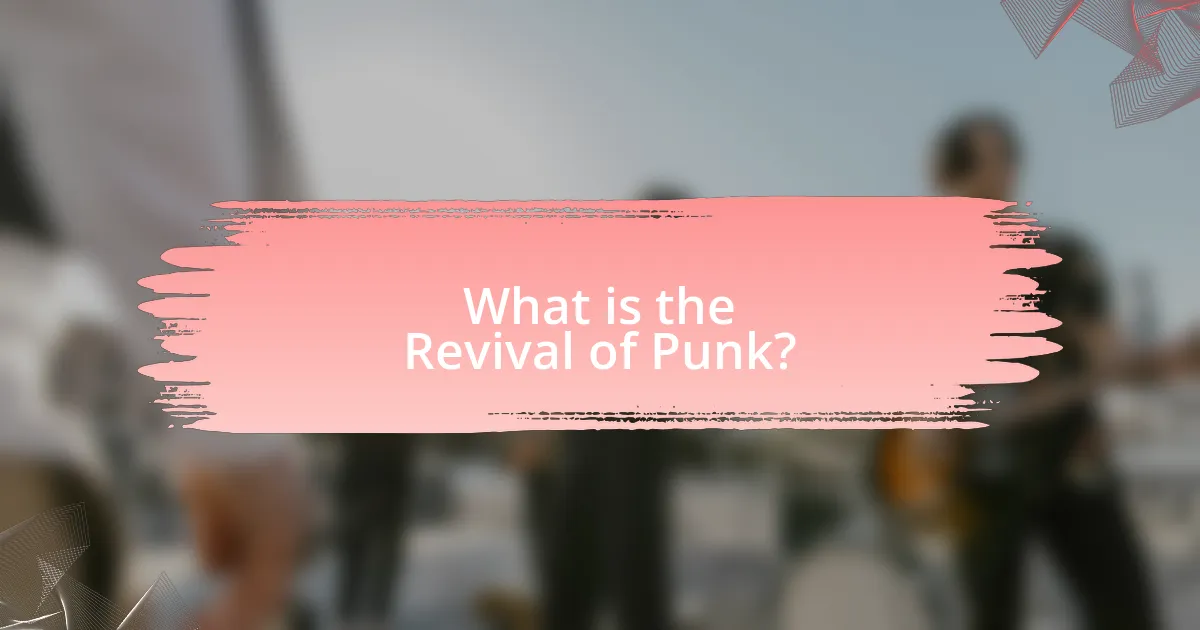
What is the Revival of Punk?
The Revival of Punk refers to the resurgence of punk music and culture that began in the late 2000s and continues to influence contemporary bands and artists. This movement is characterized by a return to the genre’s roots, emphasizing raw sound, DIY ethics, and social and political commentary. Notable examples include bands like Green Day and Blink-182, who have incorporated punk elements into mainstream music, while newer acts such as Idles and Fontaines D.C. have revitalized the genre with fresh perspectives and innovative sounds. The revival is also marked by a growing interest in punk’s historical significance, as seen in documentaries and literature that explore its impact on music and society.
How has the punk genre evolved over the years?
The punk genre has evolved significantly since its inception in the 1970s, transitioning from a raw, rebellious sound to a more diverse and commercially viable form. Initially characterized by fast tempos, simple chords, and anti-establishment lyrics, punk music laid the groundwork for various subgenres, including pop-punk, hardcore punk, and post-punk. By the 1990s, bands like Green Day and Blink-182 brought punk into the mainstream, incorporating melodic elements and broader themes, which expanded its audience. In the 2000s and beyond, modern bands such as Paramore and Fall Out Boy have further redefined punk by blending it with pop, electronic, and alternative influences, showcasing its adaptability and continued relevance in contemporary music. This evolution reflects both cultural shifts and the genre’s ability to resonate with new generations while maintaining its core ethos of rebellion and individuality.
What historical events influenced the revival of punk?
The revival of punk was significantly influenced by the socio-political climate of the late 1990s and early 2000s, particularly the disillusionment with mainstream culture and the rise of anti-establishment sentiments. Events such as the 1999 WTO protests in Seattle highlighted public frustration with globalization and corporate power, resonating with punk’s core ethos of rebellion and resistance. Additionally, the emergence of pop-punk bands like Green Day and Blink-182 in the mid-1990s brought punk back into the mainstream, while the DIY ethic and grassroots movements, such as the punk rock festivals and independent labels, reinforced the genre’s authenticity and connection to its roots. These factors collectively contributed to a renewed interest in punk music and culture, shaping its revival.
How do modern bands pay homage to classic punk elements?
Modern bands pay homage to classic punk elements by incorporating fast tempos, raw guitar riffs, and anti-establishment lyrics into their music. These bands often emulate the DIY ethos of early punk by self-releasing albums and organizing grassroots shows, reflecting the original punk movement’s spirit. For instance, bands like Idles and Fontaines D.C. draw inspiration from the aggressive sound and lyrical themes of 1970s punk, while also addressing contemporary social issues, thus bridging the gap between past and present punk culture.
Why is the revival of punk significant in today’s music scene?
The revival of punk is significant in today’s music scene because it reintroduces themes of rebellion and social commentary that resonate with contemporary issues. Modern punk bands, such as Idles and Fontaines D.C., address topics like mental health, political unrest, and identity, reflecting the current societal climate. This resurgence has led to a renewed interest in DIY ethics and grassroots movements, reminiscent of the original punk era in the 1970s, which emphasized authenticity and self-expression. The impact of this revival is evident in the increasing number of punk festivals and the integration of punk elements into mainstream music, demonstrating its relevance and influence in shaping today’s cultural landscape.
What cultural movements are driving the resurgence of punk?
The resurgence of punk is primarily driven by the DIY (Do It Yourself) ethos, social activism, and the influence of digital media. The DIY movement encourages artists to create and distribute their music independently, reflecting punk’s original spirit of self-sufficiency and rebellion against mainstream norms. Social activism, particularly around issues like climate change, racial justice, and mental health, resonates with punk’s historical roots in challenging societal issues. Additionally, digital media platforms enable new bands to reach audiences directly, fostering a global community that shares punk’s values of authenticity and resistance. This combination of DIY culture, activism, and digital connectivity has revitalized punk, making it relevant to contemporary audiences.
How does the revival of punk reflect current societal issues?
The revival of punk reflects current societal issues by addressing themes of inequality, political discontent, and social justice. Modern punk bands often incorporate lyrics that critique government policies, economic disparity, and systemic racism, mirroring the frustrations of younger generations. For instance, bands like Idles and Rise Against tackle topics such as mental health and climate change, resonating with audiences who feel marginalized or unheard. This alignment with contemporary struggles demonstrates punk’s enduring relevance as a voice for dissent and activism in today’s society.
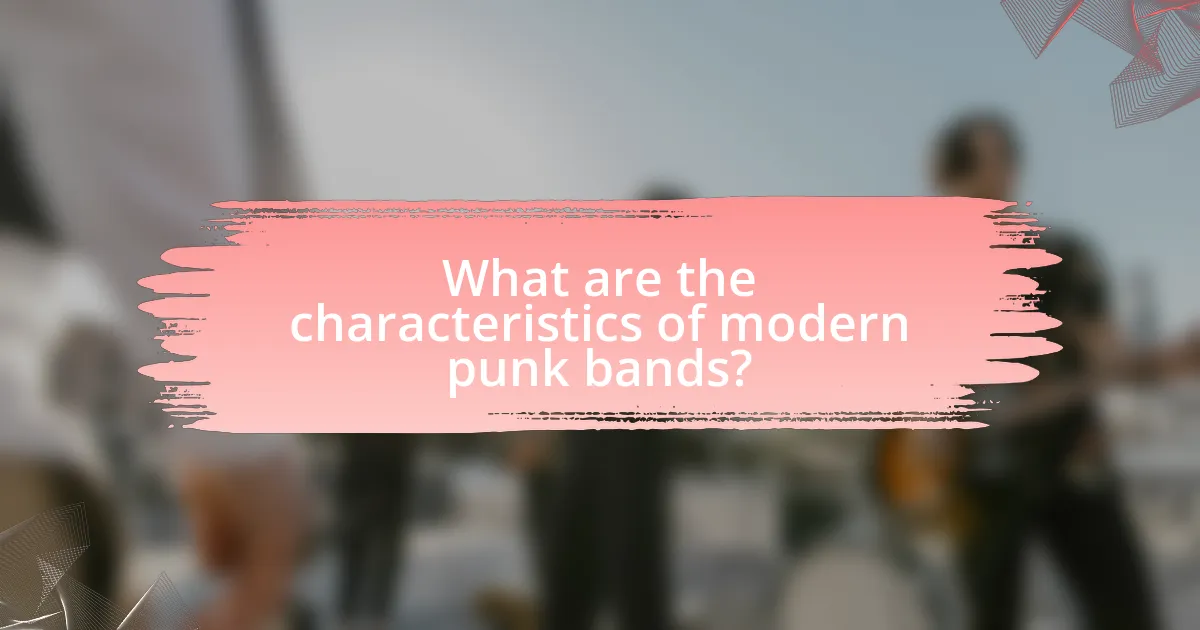
What are the characteristics of modern punk bands?
Modern punk bands are characterized by a blend of traditional punk elements with contemporary influences, often incorporating diverse musical styles, political themes, and a DIY ethos. These bands frequently experiment with genres such as pop, metal, and electronic music, reflecting the evolution of punk beyond its original sound. Lyrically, modern punk often addresses social issues, personal struggles, and political activism, resonating with a new generation of listeners. Additionally, the DIY approach remains prevalent, with many bands self-producing their music and utilizing social media for promotion, which enhances their connection with fans. This combination of musical diversity, thematic relevance, and independent production methods illustrates how modern punk bands are redefining the genre while staying true to its roots.
How do modern punk bands differentiate themselves from their predecessors?
Modern punk bands differentiate themselves from their predecessors by incorporating diverse musical influences and addressing contemporary social issues. Unlike earlier punk bands that primarily focused on rebellion against established norms, modern punk often blends genres such as pop, electronic, and hip-hop, creating a more eclectic sound. For instance, bands like Paramore and PVRIS have integrated pop elements into their music, appealing to a broader audience while maintaining punk’s core ethos of authenticity and self-expression. Additionally, modern punk lyrics frequently tackle current topics such as mental health, identity, and political activism, reflecting the complexities of today’s society. This evolution in sound and thematic content illustrates how modern punk bands are redefining the genre while still honoring its roots.
What new sounds and styles are being incorporated into modern punk?
Modern punk is incorporating diverse sounds and styles such as electronic elements, pop influences, and hip-hop rhythms. Bands like IDLES and Amyl and the Sniffers blend traditional punk with experimental sounds, creating a fusion that resonates with contemporary audiences. This evolution reflects a broader trend where punk artists are embracing genre-crossing collaborations, as seen in the rise of punk-infused pop music, which has gained traction in mainstream culture. The integration of these new styles not only revitalizes the genre but also attracts a wider audience, demonstrating punk’s adaptability and relevance in today’s music landscape.
How do lyrics in modern punk reflect contemporary themes?
Lyrics in modern punk reflect contemporary themes by addressing social issues such as political disillusionment, mental health, and identity struggles. For instance, bands like IDLES and Anti-Flag incorporate critiques of systemic inequality and personal narratives that resonate with today’s youth, highlighting feelings of alienation and frustration. The song “Danny Nedelko” by IDLES celebrates immigrant solidarity, directly responding to current global debates on immigration. Additionally, the rise of mental health awareness in society is mirrored in tracks like “Breathe” by the band The Menzingers, which discusses anxiety and the pressures of modern life. These examples illustrate how modern punk serves as a voice for current societal challenges, making the genre relevant and impactful in today’s cultural landscape.
What role does technology play in the revival of punk?
Technology plays a crucial role in the revival of punk by enabling modern bands to produce, distribute, and promote their music independently. Digital audio workstations allow artists to create high-quality recordings without the need for expensive studio time, while platforms like Bandcamp and SoundCloud facilitate direct distribution to audiences. Additionally, social media channels such as Instagram and TikTok provide a means for punk bands to engage with fans and build communities, reminiscent of the grassroots movements of the original punk era. This democratization of music production and promotion has led to a resurgence of punk’s DIY ethos, allowing diverse voices and styles to emerge within the genre.
How are social media and streaming platforms influencing modern punk bands?
Social media and streaming platforms are significantly influencing modern punk bands by providing them with direct access to audiences and enabling independent distribution of their music. These platforms allow punk bands to share their music, engage with fans, and promote their events without the need for traditional record labels. For instance, bands like Amyl and the Sniffers have gained popularity through platforms like Spotify and Instagram, which facilitate viral marketing and community building. Additionally, data from the Recording Industry Association of America (RIAA) indicates that streaming now accounts for over 80% of music industry revenue, highlighting the importance of these platforms for emerging artists in reaching wider audiences and sustaining their careers.
What impact does DIY culture have on the production and distribution of punk music?
DIY culture significantly democratizes the production and distribution of punk music by enabling artists to create and share their work independently. This cultural movement encourages musicians to bypass traditional record labels and commercial channels, allowing for greater creative freedom and authenticity. For instance, the rise of home recording technology and online platforms has facilitated the emergence of numerous punk bands that can produce high-quality music at minimal costs. Additionally, DIY venues and independent labels have proliferated, providing essential support for local scenes and fostering community engagement. This shift has led to a more diverse range of voices and styles within the punk genre, reflecting the ethos of self-expression and resistance that punk embodies.
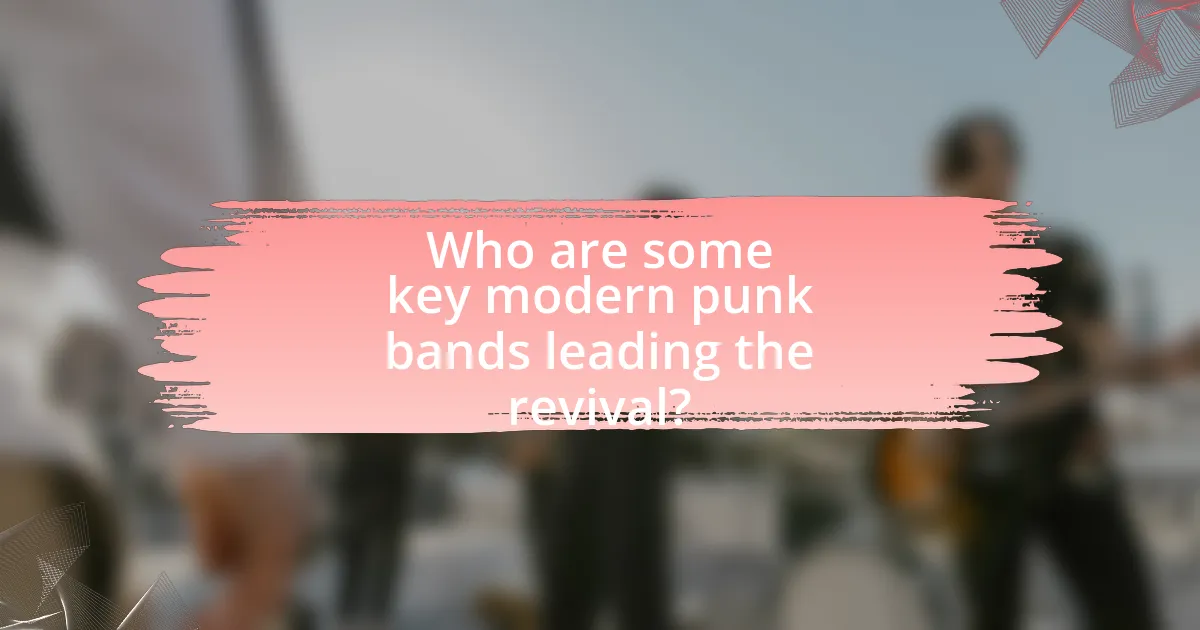
Who are some key modern punk bands leading the revival?
Key modern punk bands leading the revival include Idles, Fontaines D.C., and Amyl and the Sniffers. Idles, known for their energetic performances and socially conscious lyrics, have gained significant attention since their debut album “Brutalism” in 2017. Fontaines D.C. emerged from Dublin with their critically acclaimed album “Dogrel” in 2019, blending punk with poetic lyricism. Amyl and the Sniffers, hailing from Australia, have made waves with their raw sound and dynamic stage presence, particularly with their self-titled debut album released in 2019. These bands exemplify the resurgence of punk by infusing contemporary themes and diverse influences into the genre.
What are the defining features of influential modern punk bands?
Influential modern punk bands are characterized by their fusion of traditional punk elements with contemporary musical styles, a strong emphasis on social and political commentary, and a DIY ethos. These bands often incorporate diverse genres such as pop, metal, and electronic music, reflecting the evolution of punk beyond its original sound. For instance, bands like Paramore and Rise Against blend punk with pop and rock influences while addressing issues like mental health and social justice in their lyrics. Additionally, the DIY ethos remains prevalent, with many modern punk bands self-releasing music and organizing their own tours, which maintains the genre’s rebellious spirit.
How have these bands contributed to the punk revival?
These bands have contributed to the punk revival by reinvigorating the genre with fresh sounds, themes, and a return to its DIY ethos. For instance, bands like Green Day and Blink-182 have blended punk with pop elements, making it accessible to a new generation while maintaining punk’s rebellious spirit. Additionally, the resurgence of underground punk scenes, exemplified by groups such as The Menzingers and PUP, has emphasized authenticity and grassroots movements, echoing the original punk movement’s values. This combination of innovation and tradition has helped to sustain and evolve punk music, ensuring its relevance in contemporary culture.
What are some notable albums or songs from these bands?
Notable albums and songs from modern punk bands include “American Idiot” by Green Day, which features the iconic title track and “Boulevard of Broken Dreams.” Another significant album is “The Black Parade” by My Chemical Romance, known for songs like “Welcome to the Black Parade” and “Teenagers.” Additionally, “Sick Senses” by the band The Interrupters includes popular tracks such as “She’s Kerosene.” These albums and songs exemplify the contemporary evolution of punk music, showcasing both thematic depth and musical innovation.
How do modern punk bands engage with their audiences?
Modern punk bands engage with their audiences through interactive performances, social media engagement, and community involvement. These bands often create an immersive concert experience by encouraging crowd participation, such as sing-alongs and mosh pits, which fosters a sense of connection and energy between the performers and the audience. Additionally, they utilize platforms like Instagram, Twitter, and TikTok to communicate directly with fans, share behind-the-scenes content, and promote upcoming shows, thereby maintaining a continuous dialogue. Furthermore, many modern punk bands participate in local events and activism, aligning themselves with social causes that resonate with their audience, which strengthens their community ties and enhances fan loyalty. This multifaceted approach not only keeps audiences engaged but also reinforces the punk ethos of inclusivity and rebellion.
What strategies do they use to connect with fans both online and offline?
Modern punk bands connect with fans both online and offline through social media engagement, live performances, and community events. Social media platforms like Instagram and Twitter allow bands to share updates, interact directly with fans, and create a sense of community. Live performances, including concerts and festivals, provide opportunities for face-to-face interaction, fostering a deeper connection. Additionally, many bands participate in local events or collaborate with grassroots organizations, enhancing their presence in the community and solidifying fan loyalty. These strategies are effective as they leverage both digital and physical spaces to build relationships with their audience.
How do live performances differ from traditional punk shows?
Live performances today differ from traditional punk shows primarily in their production quality and audience engagement. Modern punk bands often incorporate advanced sound systems, lighting effects, and multimedia elements, enhancing the overall experience compared to the raw, unpolished nature of early punk shows, which emphasized spontaneity and DIY aesthetics. For instance, while traditional punk shows typically featured minimal equipment and a focus on the music itself, contemporary performances may include elaborate stage setups and professional sound engineering, reflecting a shift towards a more polished presentation. This evolution aligns with the broader trend in the music industry where live performances are increasingly seen as a key revenue source, leading to investments in production that were less common in the original punk scene.
What can aspiring punk musicians learn from the revival of punk?
Aspiring punk musicians can learn the importance of authenticity and DIY ethics from the revival of punk. Modern bands emphasize staying true to their roots while incorporating contemporary issues, reflecting the genre’s original spirit. For instance, bands like Idles and Fontaines D.C. address social and political themes, resonating with today’s audiences and demonstrating that punk can evolve while maintaining its core values. This revival showcases that engaging with current events and personal experiences can create a powerful connection with listeners, reinforcing the idea that punk remains a relevant and dynamic form of expression.
What best practices should they follow to succeed in the modern punk scene?
To succeed in the modern punk scene, bands should prioritize authenticity, engage with their audience through social media, and collaborate with other artists. Authenticity resonates with fans, as the punk genre has historically valued genuine expression over commercialism. Engaging with audiences on platforms like Instagram and TikTok allows bands to build a loyal following and share their message effectively. Collaborating with other artists can expand their reach and introduce them to new audiences, fostering a sense of community within the punk scene. These practices are supported by the resurgence of DIY ethics and grassroots movements in music, which emphasize personal connections and artistic integrity.
How can they effectively promote their music in today’s landscape?
Modern bands can effectively promote their music by leveraging social media platforms, engaging with their audience through live streaming, and utilizing digital distribution services. Social media allows bands to reach a global audience instantly; for instance, platforms like Instagram and TikTok have proven effective for music discovery, with TikTok generating over 175 million videos featuring music in 2020 alone. Live streaming performances create a direct connection with fans, allowing for real-time interaction and engagement, which has become increasingly popular during the pandemic. Additionally, digital distribution services like Spotify and Apple Music enable bands to reach listeners worldwide, with Spotify reporting over 356 million users as of 2021, providing a vast potential audience for new music.
